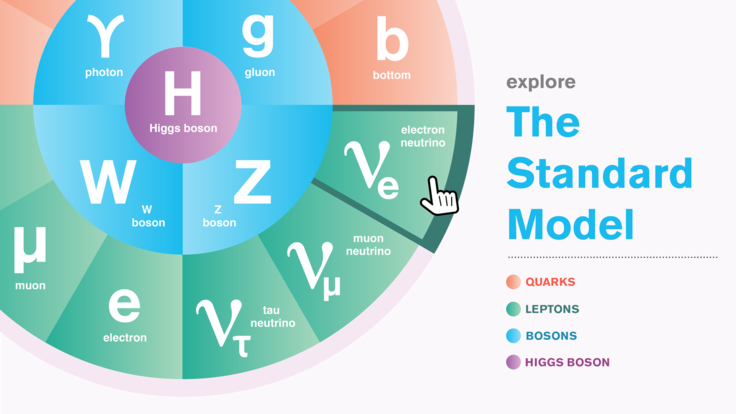I have a vivid memory of sitting cross-legged in a quiet corner of the V&A, the Victoria and Albert Museum, one extremely rainy evening in South Kensington. I was an undergraduate student in physics at Queen Mary University of London. I had made my way to the building after lectures in a desperate attempt to seek refuge from the awful weather and avoid the rush-hour commute home. There, in a museum dedicated to arts and design, I took an important step toward discovering what I wanted to do during my PhD.
PhD-application season was underway, and I was yet to decide to what part of this wonderful field I should dedicate my next four years. As I sat, I pulled out my phone and decided to read about the mysterious imbalance between matter and antimatter in the universe.
At the heart of the matter-antimatter mystery lies the idea that the Big Bang should have produced matter and antimatter in equal amounts, after which they should have bumped into one another and cancelled one another out. However, lots and lots of matter exists in the universe, and very clearly, there is comparatively little antimatter—so where did it all go?
I remember descending into a Wikipedia rabbit-hole on the subject, clicking fluorescent blue link after fluorescent blue link, reading about a messy tangle of particle decays, matrices and more parameters than anyone knows what to do with. I was hooked; I would go on to pursue research related to matter-antimatter asymmetry and how it allows all of us to exist.
Just this year, I became aware of a physicist who preceded me on that path: PhD student Rosemary Fowler.
Fowler (née Brown) was one of the first women to be awarded a bachelor’s degree in physics from the University of Bristol, in 1947. At the time, women were encouraged to forgo advanced education. Fowler decided to push forward anyway and started working on a PhD.
At the tender age of 22, Fowler made a remarkable finding. She had been tasked by her academic supervisor, Cecil Powell, with studying tracks in photographic emulsions exposed to high-energy particles from outer space.
Not long after, Powell would receive the 1950 Nobel Prize in Physics for the use of this technique to discover subatomic particles called pions. (Not included in the list of Nobel awardees was physicist Marietta Blau, who developed the technique.)
Giving the photographs a first pass was up to the “scanners”—generally women not enrolled in graduate-level classes—who searched them for signs of particle tracks. When scanner Minnie van der Merwe passed Fowler a photographic slide with an unusual particle signature, Fowler knew that what she was looking at was “new and would be very important,” she said in an interview with the BBC. “We were seeing things that hadn’t been seen before… It was very exciting.”
Fowler would later call the particle signature her “k-track.” The track entered from the left and split into three offshoots, indicating that a particle of a certain mass had decayed into three pions. What made this observation novel and exciting was that a year prior, a particle with the same mass had been seen to decay to just two pions.
What Fowler had discovered was a conundrum that countless physicists would spend nearly a decade trying to solve: “the tau-theta problem.”
Particles are given quantum numbers that describe their properties, such as charge, spin or something called “parity.” Charge and parity are brought together in a concept called “charge-parity” (CP) symmetry. CP symmetry states that the laws of physics should remain unchanged if a particle is swapped with its antiparticle (C symmetry), or if it is reflected in a mirror (P symmetry.)
The total parity of a particle is calculated by multiplying the parity of the particles into which it decays. Fowler’s particle, called “tau,” had a parity of -1, while the previously discovered particle, called “theta,” had a parity of 1. However, both of these particles had the exact same mass, indicating that they should be one and the same. It was a violation of CP symmetry—thought to be an unbreakable law of physics—for a single particle to decay in two such different ways, giving it two different identities when it came to parity.
Either CP symmetry had been violated, or the “tau” and “theta” particles were different particles after all.
Physicists rushed to make more and more precise measurements of the masses of these particles, hoping they would start to diverge, but they remained stubbornly identical. Physicists began to refer to both “tau” and “theta” particles as the “kaon.”
The fundamental force that causes radioactive decay—including the decay process that Fowler discovered—is called the weak force. In 1957, brilliant female physicist Chien-Shiung Wu devised an experiment to test interactions governed by this force. By measuring the direction in which the beta-decay of radioactive cobalt-60 occurred, Wu was able to verify that the weak interaction did indeed violate parity symmetry.
The “tau-theta” problem had finally been resolved. For the discovery, Wu’s male theorist colleagues, Tsung-Dao Lee and Chen Ning Yang, received the Nobel Prize, while Wu was overlooked.
For her part, Fowler decided to leave academia without completing her PhD. She had married fellow physicist Peter Fowler (a descendant of particle physics royalty, by virtue of being grandson to Ernest Rutherford). Rosemary assisted Peter with his work from home, while taking care of the house and raising their three daughters in post-war Britain.
In 2023 , I completed my PhD in physics. More women have entered the field since Fowler’s time, but I was still the only woman of color in my cohort.
I have Fowler’s discovery of the kaon, which raised a question Wu and her colleagues answered about CP symmetry, to thank for getting me interested in my PhD research topic: neutrinos. Like kaons, neutrinos also interact via the weak force, and current research into neutrinos examines whether they violate CP symmetry. If physicists find that they do, it will hint that they may have played a role in tipping the balance between matter and antimatter in the early universe.
But I hadn’t heard of Fowler until this year. In July, the University of Bristol awarded her an honorary doctorate, meant to “recognise the achievements of individuals who may not have been honoured during the time of their achievements.”
I am thankful to have learned about Rosemary Fowler and the other incredible women who were trailblazers in this field. While I write this, a rather faded sticker of Chien-Shiung Wu looks at me from atop my old PhD laptop. I am happily reminded that—whatever the makeup of our PhD cohorts, and however belatedly those who came before us receive their due—physicists from minority backgrounds will never have to face the science alone.







